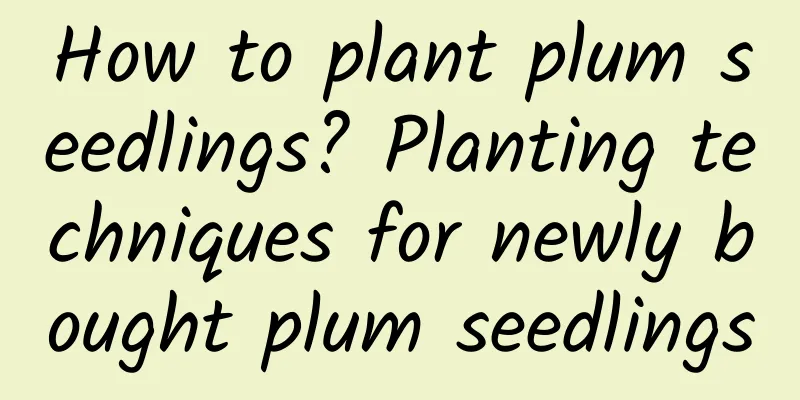How to plant plum seedlings? Planting techniques for newly bought plum seedlings

|
Plum is a very important economic fruit tree. There are many varieties currently planted, and the demand for them varies greatly from market to market. The flesh is crispy and juicy, and the taste varies from sour to sweet, so when planting plums, choosing the right variety is the key. So how do you plant plum seedlings? How to plant plum seedlings1. Garden selection Choose to plant plum seedlings in plots with high soil fertility, deep soil layer and easy drainage. Although plum seedlings have strong adaptability to soil, in order to produce high-quality plums, the soil environment must be strictly controlled. After selecting the site, deep plowing and tillage, and application of decomposed organic fertilizer are required. 2. Seedling selection and planting Select pure and strong plum seedlings, avoid diseases and insect pests, and then control the spacing to 3 meters to complete the planting. Because plum trees are self-pollinating, pollination trees need to be intercropped reasonably. 3. Water and fertilizer management After the plum trees are planted, they should be watered once in time to ensure that the trees can absorb nutrients from the soil. During the flowering and fruiting periods, the amount of watering should be increased to promote fruit production. After harvesting in winter, they should be watered once to ensure that the fruit trees can safely overwinter. Plum trees should be fertilized at least 3-4 times. Nitrogen fertilizer should be applied during the growing season to promote the growth of fruit trees. Phosphorus and potassium fertilizers should be applied during the flowering period to improve the quality of flowering. Potassium dihydrogen phosphate solution should be sprayed on the leaves during the fruiting period to increase the nutrients of the fruit. 4. Thinning flowers and fruits The fruit setting rate of plum trees is relatively high, so it is necessary to thin out the flowers and fruits appropriately to adjust their nutrient distribution. Flower thinning is generally done during the peak flowering period. Weak flowers will definitely produce very small fruits, which is not conducive to improving commodity attributes. Try to keep large fruits and strong flowers, and thin the fruits in order. 5. Pest and disease control Plum trees are prone to pests such as borer disease, fruit borers, and red spider mites. Once they occur, use carbendazim and thiophanate-methyl to spray to control the borer disease. 2.5% dichlorvos and 20% pyrethroids can be used for spraying to control them. Red spider mites can be sprayed with imidacloprid. Plum tree seedling planting timePlum is a deciduous fruit tree species, suitable for planting between November and early March of the following year. When it matures too early, the plum seedlings have not entered the dormant period, and the seedling stems are not completely lignified; too late, the plum seedlings germinate, and the rising temperature seriously affects the survival rate of planting. |
>>: How to plant newly bought orchids? Planting methods for newly bought orchids
Recommend
How to grow potted purple bamboo plum
1. Potted plant maintenance methods 1. Flower soi...
Do you need to water flowers and plants every day in summer?
1. Do you need to water every day? Different plan...
Tea tree growth environment conditions and characteristics
Tea tree growth environment conditions and requir...
What size pot is best for Tenghua roses?
Tenghua rose pot Climbing roses can be planted in...
Reasons and solutions for yellowing leaves of hydroponic green radish
Hydroponic green ivy , with its emerald green lea...
How to propagate Chlorophytum comosum by cuttings
Cutting propagation time When propagating Chlorop...
Cultivation methods and precautions of Artemisia selengensis
Growth habits of Artemisia strychnifolia The bran...
What are the advantages and disadvantages of watering flowers with soapy water? Watering flowers and plants with soapy water kills insects
Benefits of watering flowers with soapy water Soa...
Can Houttuynia cordata be hydroponically cultivated? Hydroponics cultivation methods and precautions
Can Houttuynia cordata be grown hydroponically? H...
How to grow green radish in water
1. Breeding environment 1. Change the water: When...
How to propagate Luweihua (sowing and division process)
1. Seed propagation 1. Sowing time: The sowing ti...
When to sow baby's breath seeds and how to plant them
1. Time When sowing baby's breath seeds, the ...
What is the best time to prune crabapple trees?
Regular pruning of crabapple trees can increase t...
How to water the seven-leaf lotus
How to water in the early stage of planting When ...
How to grow ranunculus on the balcony, what should be paid attention to
1. How to maintain 1. Light: Anthurium needs sunl...









